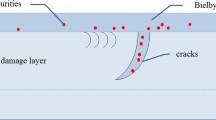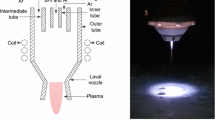Abstract
Surface damage has great influence on optical properties, especially the laser-induced damage threshold of optics, and it has become a difficult and basic issue to find suitable methods to efficiently remove the surface damage for improving the surface quality. In this paper, the characteristic evolution of brittle scratch and ground/lapped surface damage during inductively coupled plasma etching (ICPE) process are experimentally investigated on fused silica. Results of damage removal tests show ICPE can efficiently remove brittle scratch and eliminate the lateral and medial cracks. The PV (peak to valley) and RMS (root mean square) values of surface roughness increase with the exposure of lateral and medial cracks, and then gradually decreases with further etching. Finally, the ground and lapped fused silica surfaces with a size of 300 × 300 × 20 mm3 are efficiently processed by ICPE. The power spectral density analysis further demonstrates that the damage can be efficiently removed by ICPE. This study reveals the damage evolution during ICPE process and also provides technical guidance for optimizing the efficient damage removal process to rapidly improve surface quality, precision and fabrication efficiency of fused silica optics.
















Similar content being viewed by others
Abbreviations
- ICPE:
-
Inductively coupled plasma etching
- SSD:
-
Subsurface damage
- MRF:
-
Magnetorheological finishing
- MRR:
-
Material removal rate
- HFE:
-
Hydrofluoric acid etching
- IBF:
-
Ion beam figuring
References
Shen, N., Bude, J. D., & Carr, C. W. (2014). Model laser damage precursors for high quality optical materials. Optics Express, 22(3), 3393–3404.
Wang, Z., Wu, Y., Dai, Y., & Li, S. (2008). Subsurface damage distribution in the lapping process. Applied Optics, 47(10), 1417–1426.
Menapace, J. A. (2010). Developing magnetorheological finishing (MRF) technology for the manufacture of large-aperture optics in megajoule class laser systems. Office of Scientific and Technical Information Technical Reports 7842 (pp. 78421W–78421W-15).
Bude, J., Miller, P., Baxamusa, S., Shen, N., Laurence, T., Steele, W., et al. (2014). High fluence laser damage precursors and their mitigation in fused silica. Optics Express, 22(5), 5839–5851.
Miller, P. E., Suratwala, T. I., Bude, J. D., Laurence, T. A., Shen, N., Steele, W. A., et al. (2009). Laser damage precursors in fused silica. Proceedings of SPIE, 7504, 75040X.
Menapace, J., Penetrante, B., Golini, D., Slomba, A., Miller, P., Parham, T., et al. (2002). Combined advanced finishing and UV-Laser conditioning for producing UV-damage-resistant fused silica optics. Proceedings of SPIE, 4679, 56–68.
Liu, H., Ye, X., Zhou, X., Huang, J., Wang, F., Zhou, X., et al. (2014). Subsurface defects characterization and laser damage performance of fused silica optics during HF-etched process. Optical Materials, 36, 855–860.
Néauport, J., Ambard, C., Cormont, P., Darbois, N., Destribats, J., Luitot, C., et al. (2009). Subsurface damage measurement of ground fused silica parts by HF etching techniques. Optics Express, 17(22), 20448–20456.
Xu, M., Dai, Y., Zhou, L., Shi, F., Wan, W., Xie, X., et al. (2016). Investigation of surface characteristics evolution and laser damage performance of fused silica during ion-beam sputtering. Optical Materials, 58, 151–157.
Shi, F., Zhong, Y., Dai, Y., Peng, X., Xu, M., & Sui, T. (2016). Investigation of surface damage precursor evolutions and laser-induced damage threshold improvement mechanism during Ion beam etching of fused silica. Optics Express, 24(18), 20842–20854.
Kamimura, T., Akamatsu, S., Yamamoto, M., Yamato, I., Shiba, H., Motokoshi, S., et al. (2003). Enhancement of surface-damage resistance by removing a subsurface damage in fused silica. Proceedings of SPIE, 5273, 244–249.
Xu, M., Shi, F., Zhou, L., Dai, Y., Peng, X., & Liao, W. (2017). Investigation of laser-induced damage threshold improvement mechanism during ion beam sputtering of fused silica. Optics Express, 25(23), 29260–29271.
Fanara, C., Shore, P., Nicholls, J. R., Lyford, N., Kelley, J., Carr, J., et al. (2006). A new reactive atom plasma technology (RAPT) For precision machining: the etching of ULE surfaces. Advanced Engineering Materials, 8(10), 933–939.
Jourdain, R., Castelli, M., Shore, P., Sommer, P., & Proscia, D. (2013). Reactive atom plasma (RAP) figuring machine for meter class optical surfaces. Precision Engineering, 7(6), 665–673.
Shi, B., Dai, Y., Xie, X., Li, S., & Zhou, L. (2016). Arc-enhanced plasma machining technology for high efficiency machining of silicon carbide. Plasma Chemistry and Plasma Processing, 36(3), 1–10.
Arnold, T., Böhm, G., Fechner, R., Meister, J., Frost, F., Hänsel, T., et al. (2010). Ultra-precision surface finishing by ion beam and plasma jet techniques-status and outlook. Nuclear Instruments and Methods in Physics Research, 616(2–3), 147–156.
Meister, J., & Arnold, T. (2011). New process simulation procedure for high-rate plasma jet machining. Plasma Chemistry and Plasma Processing, 31(1), 91–107.
Arnold, T., & Böhm, G. (2012). Application of atmospheric plasma jet machining (PJM) for effective surface figuring of SiC. Precision Engineering, 36(4), 546–553.
Arnold, T., Böhm, G., & Paetzelt, H. (2016). Nonconventional ultra-precision manufacturing of ULE mirror surfaces using atmospheric reactive plasma jets. Proceedings of SPIE, 9912, 99123N.
Castelli, M., Jourdain, R., Morantz, P., & Shore, P. (2012). Rapid optical surface figuring using reactive atom plasma. Precision Engineering, 36(3), 467–476.
Zhang, J., Li, B., Wang, B., & Dong, S. (2013). Analysis on formation mechanism of ultra-smooth surfaces in atmospheric pressure plasma polishing. International Journal of Advanced Manufacturing Technology, 65(9–12), 1239–1245.
Li, S., Wang, Z., & Wu, Y. (2008). Relationship between subsurface damage and surface roughness of optical materials in grinding and lapping processes. Journal of Materials Processing Technology, 205(1), 34–41.
Ren, K., Luo, X., Zheng, L., Bai, Y., Li, L., Hu, H., et al. (2014). Belt-MRF for large aperture mirrors. Optics Express, 22(16), 19262–19276.
Cheng, H. B., Feng, Z. J., & Wang, Y. W. (2005). Surface roughness and material-removal rate with magnetorheological finishing without subsurface damage of the surface. Journal of Optical Technology, 72(11), 865–871.
Chen, H., Zhou, L., Xie, X., Shi, B., & Xiong, H. (2016). Rapidly removing grinding damage layer on fused silica by inductively coupled plasma processing. Proceedings of SPIE, 9683, 96830B.
Dai, Z., Xie, X., Chen, H., & Zhou, L. (2018). Non-linear compensated dwell time for efficient fused silica surface figuring using inductively coupled plasma. Plasma Chemistry and Plasma Processing, 38(2), 443–459.
Xin, Q., Li, N., Wang, J., Wang, B., Li, G., Ding, F., et al. (2015). Surface roughening of ground fused silica processed by atmospheric inductively coupled plasma. Applied Surface Science, 341, 142–148.
Xin, Q., Su, X., & Wang, B. (2016). Modeling study on the surface morphology evolution during removing the optics surface/subsurface damage using atmospheric pressure plasma processing. Applied Surface Science, 382, 260–267.
Takino, H., Yamamura, K., Sano, Y., & Mori, Y. (2010). Removal characteristics of plasma chemical vaporization machining with a pipe electrode for optical fabrication. Applied Optics, 49(23), 4434.
Oh, C., Kang, M., & Hahn, J. W. (2015). Accurate measurement of atomic chlorine radical density in process plasma with spatially resolvable optical emission spectrometer. International Journal of Precision Engineering and Manufacturing, 16(9), 1919–1924.
Sung, S., Kim, C. H., Lee, J., Jung, J. Y., Jeong, J., Choi, J. H., et al. (2014). Advanced metal lift-offs and nanoimprint for plasmonic metal patterns. International Journal of Precision Engineering and Manufacturing-Green Technology, 1(1), 25–30.
Lee, H., Chung, M., Ahn, H. G., Kim, S. J., Park, Y. K., & Jung, S. C. (2015). Effect of the surfactant on size of nickel nanoparticles generated by liquid-phase plasma method. International Journal of Precision Engineering and Manufacturing, 16(7), 1305–1310.
Lian, Y. S., Chen, H. F., & Mu, C. L. (2019). Performance of microtextured tools fabricated by inductively coupled plasma etching in dry cutting tests on medium carbon steel workpieces. International Journal of Precision Engineering and Manufacturing-Green Technology, 6(2), 175–188.
Acknowledgements
This research work was supported by Natural Science Foundation of China (51835013, U1801259), Natural Science Foundation of Hunan Province (2017JJ1004).
Author information
Authors and Affiliations
Corresponding author
Additional information
Publisher's Note
Springer Nature remains neutral with regard to jurisdictional claims in published maps and institutional affiliations.
Rights and permissions
About this article
Cite this article
Dai, Z., Chen, S., Xie, X. et al. Investigation of Grinding and Lapping Surface Damage Evolution of Fused Silica by Inductively Coupled Plasma Etching. Int. J. Precis. Eng. Manuf. 20, 1311–1323 (2019). https://doi.org/10.1007/s12541-019-00142-9
Received:
Revised:
Accepted:
Published:
Issue Date:
DOI: https://doi.org/10.1007/s12541-019-00142-9




